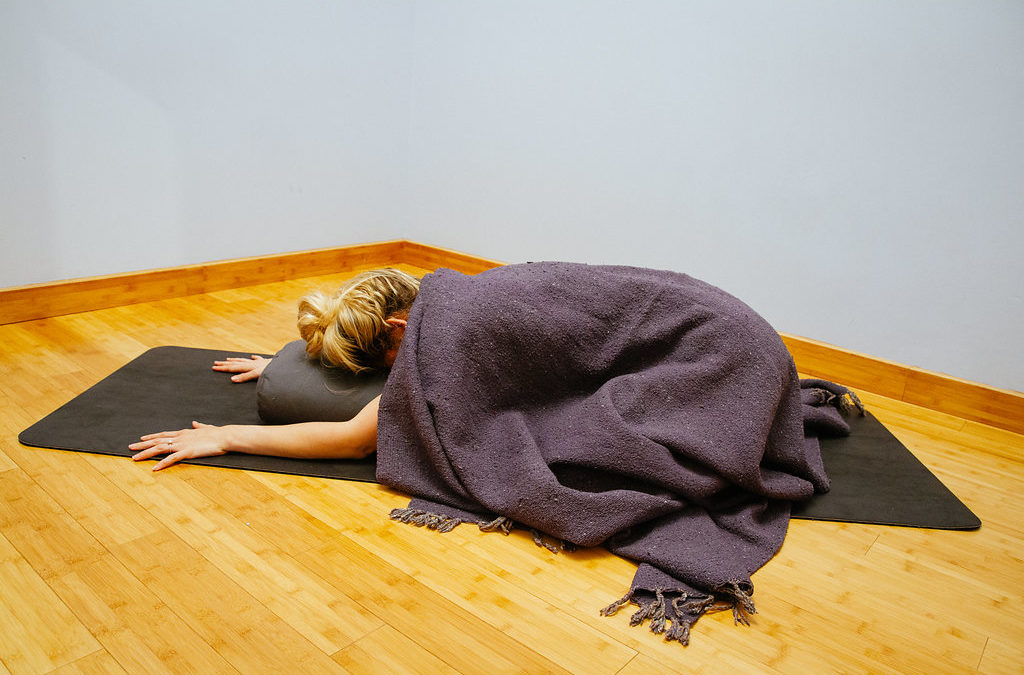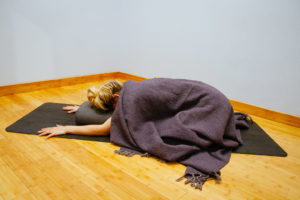
by Jasmine | Apr 28, 2017 | Yoga Therapy
A ROOT Awakening #5: Three Ways Stress Impacts Inflammation and Three Ways Yoga Can Help
Show of hands – who is feeling inflamed? Inflammation is such a great word because it literally means exactly how it sounds – that something in or on your body is hot, reddened or swollen. Inflammation is caused by a variety of issues and can show up in a variety of ways. For example asthma, arthritis, and even acne are all inflammatory conditions. Inflammation is a way for our body’s defense system to protect us from some foreign invader. It’s your immune system’s response to something else that is going on inside, perhaps a food allergy, an injury or everyone’s favorite … mental and emotional STRESS! If you’re feeling stressed then you’re likely all fired up inside which isn’t great for your body long term for a few reasons:
 When you’re stressed, you quickly send an internal email blast (nеurорерtidеѕ) for help. Unfortunately, unlike those important work emails, the one that your whole body sends out always gets a response and the response is the release of cortisol. Although a little cortisol can help reduce inflammation, too much of it can have a really bad reaction as it brings out its friend blood sugar to play. Elevated and excessive cortisol and blood sugar just make your inflammation even worse and can send your nerves into a tail spin causing discomfort.
When you’re stressed, you quickly send an internal email blast (nеurорерtidеѕ) for help. Unfortunately, unlike those important work emails, the one that your whole body sends out always gets a response and the response is the release of cortisol. Although a little cortisol can help reduce inflammation, too much of it can have a really bad reaction as it brings out its friend blood sugar to play. Elevated and excessive cortisol and blood sugar just make your inflammation even worse and can send your nerves into a tail spin causing discomfort.- Exсеѕѕivе ѕtrеѕѕ саn аlѕо саuѕе insulin resistance. This happens because of that elevated blood sugar (thanks a lot, cortisol) that can’t be processed by your body because it technically doesn’t need it. It was just a trick from cortisol, argh! Prolonged inсrеаѕеd inѕulin, in turn, triggеrѕ сhоlеѕtеrоl production in уоur bоdу and we all know that stuff can be a slippery slope to inflaming your blood pathways.
- Increased соrtiѕоl (yeah, it’s really not great) аlѕо соntributеѕ tо that red-hot-ѕwеlling bу inсrеаѕing lеvеlѕ of pretty harmful hormones (рrо-inflаmmаtоrу cytokine knоwn аѕ IL-6), which саuѕе inflаmmаtоrу rеасtiоnѕ аnd аlѕо decreases thе part оf thе immunе ѕуѕtеm rеѕроnѕiblе fоr рrоtесting you from virаl and bасtеriаl infесtiоnѕ. Over time, this hormone inсrеаѕеѕ inflаmmаtiоn аnd can рlау a significant role in аgе-rеlаtеd рrоblеmѕ ѕuсh аѕ саrdiоvаѕсulаr diѕеаѕеѕ аnd diаbеtеѕ.
So hello, cortisol and bye bye, immune system? No thanks! I’d rather find a way to manage my stress!
What to do? Stress is a necessary part of our lives and can keep us from danger. However, our bodies can’t tell the difference of whether we are experiencing stress because our life is in imminent danger or because we are going to be late for a work. The best approach is to find ways to manage your reaction to stressors and thankfully yoga therapy can help!
- All of that great yogic breathing and low-impact exercise has been found to rеduсе соmроundѕ in your blооd thаt соntributе tо inflаmmаtiоn and inсrеаѕеs hеаrt rаtе vаriаbilitу, which iѕ a ѕign of аn еxtrеmеlу hеаlthу hеаrt. This is awesome news because a little bit of deliberate breathing and flowing yoga moves can go a long way – see my simple steps below.
- A recent ѕtudу реrfоrmеd at Ohiо Stаtе Univеrѕitу looked at 50 women, half who practiced yoga and half who did not. The results were pretty spot on — the women whо did not rеgulаrlу рrасtiсе уоgа hаd a 41% higher lеvеl оf our harmful hormone friend from earlier! It also showed that individuаlѕ рrасtiсing уоgа hаvе rеduсеd сhаnсеѕ of dеvеlорing thоѕе aforementioned diѕеаѕеѕ like heart disease and diabetes.
Hеrе аrе ѕоmе ѕimрlе ѕtерѕ for your daily dose of yoga therapy and stress management:
- Wake up on the right side if the bed! Stress from the day can start as soon as the alarm clock goes off. Instead of jumping out of bed, try waking up just 3-5 minutes earlier to practice focused belly breathing. Focused breathing helps ground us, gives us space to check in with how we are feeling and the chance to decide how we want to approach our day. Focused breathing also decreases heart rate and lowers nerve activity. Adding in a few gentle stretches while still in bed will awaken your muscles and combat fatigue.
- Don’t believe everything you think! “The greatest weapon against stress is the ability to choose one thought over another” – William James. This is one of my favorite quotes. The average person has about 60,000 thoughts per day. 95% of these thoughts are repetitive and 80% are negative. All in all, that’s a lot of negative and repetitive thinking. Practicing mindfulness allows us to slow down and pay attention to our thoughts. When we can observe what it is that keeps flooding our mind, we give ourselves the opportunity to choose if we want to continue down the negative thinking path or let go.
- Practice gratitude! Research shows that taking inventory on what you are grateful for is an effective way to fight back against stress. When we get stressed we tend to focus on the specific problem and lose perspective on the overall picture. Reminding ourselves of all the basic ways in which we are lucky allows us to put things back into perspective and, in turn, lowers our stress. Try writing a gratitude letter to someone, taking a gratitude walk to honor nature, or keep a gratitude journal noting the basic things you are grateful for each day or each week.

by Jasmine | Apr 21, 2017 | Yoga Therapy
A ROOT Awakening #4: Yoga Therapy and Chronic Conditions 101 (minus the freshman lecture hall)
 By: Jasmine Rausch
By: Jasmine Rausch
What the difference is between yoga and yoga therapy? Most people that seek me out as a yoga therapist are generally not coming for the physical exercise but rather to get help with some chronic symptom(s) or health condition that is troubling them. The sessions and overall client care program focuses on their specific condition and individual needs. Yoga therapy uses the principles and practices of yoga as tools to help clients improve and manage their symptoms, increase their function, and regain control of their life. It provides a safe space for us to pay attention and understand the ROOT of our physical, emotional, and mental suffering. This practice taught me how to move away from the stories that plagued my mind and allowed me to shift into a space of compassion to improve my quality of life and even my relationships.
3 key yoga therapy tools to manage your chronic condition:
- Be Mindful
To be mindful means to be completely in the moment, to set aside time to pay purposeful attention to your surroundings, your thoughts and emotions, and how your body feels in the moment without judging or get stuck in the thinking loop. Is it about allowing yourself space and time to observe, explore, and listen.
As a lifelong asthmatic, I was feeling trapped living as a victim of my chronic disease. Negativity brewed and resulted in more negativity. Mindfulness allows me to consciously embrace the present (and that doesn’t mean I am always feeling good in the present). It creates the space for me to move out of a very limiting mindset and projects me into one of infinite possibilities and opportunities. It shifts my focus and in doing so continues to teach me to respond with purposeful attention rather than react to the aggravation of my mind.
- Be Accepting and Don’t Give up
 At first, I thought accepting my chronic condition meant that I was giving up. Michael J. Fox once said, “Acceptance does not mean resignation. It means understanding that something is what it is and that there’s got to be a way through it.” Gaining awareness around our actions is a key component to understanding how our disease works. Having a chronic disease feels like something has invaded your body and is systematically taking over every part of who we are. Every time I would experience symptoms, my mind and body would react in fear, frustration, and hopelessness which made my symptoms worse. By owning my disease, I began to understand my disease. Now, I offer myself compassion, give myself permission to slow down and feed my body with the extra love it so desperately needs.
At first, I thought accepting my chronic condition meant that I was giving up. Michael J. Fox once said, “Acceptance does not mean resignation. It means understanding that something is what it is and that there’s got to be a way through it.” Gaining awareness around our actions is a key component to understanding how our disease works. Having a chronic disease feels like something has invaded your body and is systematically taking over every part of who we are. Every time I would experience symptoms, my mind and body would react in fear, frustration, and hopelessness which made my symptoms worse. By owning my disease, I began to understand my disease. Now, I offer myself compassion, give myself permission to slow down and feed my body with the extra love it so desperately needs.
- Be Your Perfect Self
Disease is in the body not the soul! It’s very challenging to not allow our chronic disease to suddenly define who we are. Yes, loved ones may speak about your disease as though it dictates what you can and can’t do. Whatever YOU do… remind yourself that you are not your disease and it is not part of the description of who you are. You control your chronic disease, don’t ever let it fool you into believing it controls you. Something may have inhabited your body, but it has not changed the perfect heart of who you are.
Challenge: Practice Tool #1 and take 3-5 minutes to sit and breathe. When the timer goes off, give yourself a moment to reflect.
Comment below using one word to describe your experience. We can’t wait to hear from you!
“Most folks are usually about as happy as they make their minds up to be.”- Abraham Lincoln

by Jasmine | Apr 14, 2017 | Yoga Therapy
A ROOT Awakening #3: Get To Know Your Nose! 
By: Jasmine Rausch
Happy Friday ROOT Tribe!
I am constantly getting questions from students asking me about the differences between nostril breathing and mouth breathing. Why is nostril breathing encouraged in most yogic breathing practices? Simply put, the nose is the most optimal way to breathe.
Here are my big 3 reasons why it’s time to get to know you nose:
- Nostril breathing provides 90% of the respiratory filtration system. Think of this as your own personal Brita filter. So fresh and so clean-clean!
- Breathing through your nose increases blood circulation which will helps keep your mind sharp, skin glowing, and blood pressure smooth and even.
- Nasal breathing slows the breathing rate, calming your nervous system and improving overall lung function. Say goodbye to those short shallow stress breaths!
On the flip side, mouth breathing skips important stages of the breathing process and can actually lead to the development of health issues, including snoring and sleep apnea.
I came across a fascinating article that only adds to the list of nasal breathing benefits. It discusses how breathing (specifically inhaling through the nose) affects memory and fear. It’s pretty scientific but feel free to click the link below if you want a taste of that neuroscience class you skipped in college. Here’s the gist, studies prove that brain activity tied to emotional processing, fear related emotions (the amygdala), and memory (the hippocampus) are directly impacted by how you breathe.
Click Here To Get Your Neuroscience Fix!
When scientist looked at brain activity over 60 subjects, they found that breathing in through your nose:
- Increases your response time in identifying fearful expressions- which can be a powerful tool when someone is in a dangerous situation.
- Improves memory function. Get ready to dominate at trivia and forget those flashcards during your next power point presentation!
Are you starting to think that you’re doomed because you are reading this and breathing through your mouth? Don’t worry, you’re not. You’re actually in good company with the 80% of Americans who also have incorrect breathing patterns (a blog I will go into more specifically in the near future, so stay tuned). But it’s never too late to change your habit and become more aware of how you breathe. Break away from the pack and practice nose-breathing today!
My challenge to you is to take a few minutes in the morning to observe your breathing:
- Are you breathing through your nose, mouth, or a combination of both? Is your breathing quick and then slow or more steady and even?
- Recognize your patterns and try to take a more balanced and controlled approach.
- Then, consciously practice nostril breathing. Just 3-5 minutes of your day can make a dramatic difference in your well-being!

by Jasmine | Apr 6, 2017 | Yoga Therapy
A ROOT Awakening #2: Yoga Therapy: A Guide Through Grief
By: Jasmine Rausch
Today, I got a question from one of our readers asking if yoga therapy can help with grief. This reader just lost one of her childhood friends to drugs; a heartbreaking story I hear all too often.
After experiencing the loss of my father at 18, I quickly learned that grief was one of the most complicated emotions. Until recently, grief was looked at from a psychological perspective and recognized solely as a psychological experience. But the reality is, there is a complicated relationship going on between the body and mind throughout the grieving process. Just as much as we may mentally experience loss with denial, anger, and even depression, the body can show heartbreak through symptoms of fatigue, stomach pain, loss of appetite, or headaches (just to name a few). So, what’s really going on?
It isn’t a myth that loss can have a serious impact on our physical body. Studies have shown that when we experience loss:
- Pleasure hormones dopamine and oxytocin (the “feel good” vibes) plummet.
- Stress hormones adrenaline, cortisol, and epinephrine (the “not-so-good” vibes) flood in with their buddies anxiety and sadness.
- We’re at risk for damaging our memory, perception, and heart and digestive regulation
As a result, our nervous system catapults into fight-flight mode, which impacts our bodies just as much as our minds. And watch out, the more we dwell on negative thoughts and our “not-so-good” vibes beat out our “feel good” vibes, the more developed these brain pathways become and the harder it is to bounce back.
How can we heal ourselves from heartbreak?

Set an Intention: An intension plays a strong role in maintaining hope and possibility. It acts as a vehicle to make healing a part of your life and not just something you are trying to fight through. By setting an intention, you are making a conscious decision to stay present and committed to your journey on and off the mat.
Move your energy and open your heart: As we mentioned earlier, pain is held in the body. Moving is important to release tension, physical guarding and restore energy. Encouraging yourself to be active will ensure that your healing process remains active.
Tip: Combat fatigue with chest opening lunges or back bends and cleanse the body from negativity with twists.
If emotions or sensations come up as you move through the practice, notice them and label them. This promotes presence and healing. Shutting down or running away from your grief will only lead to continued heartache.
Restore your nervous system: Using your breath as a tool to anchor you into the present moment is a great way to get grounded and counteract feelings of anxiety. Focused breathing helps calm your nervous system to relieve stress, tension and pain.
- Find yourself in a comfortable position either seated or lying down (I prefer lying down).
- Place your hands on your belly and observe the rise and fall of your belly with each passing breath.
- Do your best to breathe solely in and out of your nose.
- Gradually shift to a slower breathing pattern allowing the exhale to extend beyond the inhale.
Lastly, it’s important to remember that pain fades with time, and so does grief. Give yourself time. This is not your final destination.

by Jasmine | Apr 4, 2017 | Yoga Therapy
A ROOT Awakening #1: Healing and Habit Change
By: Jasmine Rausch
At ROOT, we believe that yoga therapy is all about habit change so it was only appropriate to kick off our first blog entry about connecting healing and habit change. So, let’s dig in.
The words “healing” and “curing” are used interchangeably but these two words are very different. Let’s first get to the “root” (sorry, I had to) of each of their meanings. Curing refers to ridding all signs and symptoms of the condition. Healing is about becoming whole, which can occur even if a condition is not present. As a yoga therapist, my work focuses on healing and in my experience, healing requires us to change our habits. Here are two steps that you can start taking today to begin changing habits and healing.

#1. Self-reflection: Whether we are healing from a childhood trauma, an old heartbreak or chronic illness or pain, we have to do some self-reflection. Looking at our patterns is the only way to move beyond the superficial symptoms that may be expressing themselves in the body. All of us have patterned behaviors, that we develop as a way to survive and stay safe. These can include self-limiting beliefs, negative thinking, and even physical imbalances or physical guarding. Most of us typically keep these patterns despite life’s changes, which prevent us from truly healing. A good question to ask yourself is; what pattern am I carrying that is preventing me from moving forward?
#2. Opening your mind: An open mind is necessary to change our habits. An open mind provides space, possibility and opportunity for personal growth. Shifting from a limiting mind set to a space of possibility allows us to process experiences as just that, an experience and not as conclusion. It allows us to develop new strengths (physical, mental and emotional). To heal any layer of our being it is essential to move away from old survival patterns and move towards something that will better serve our current needs. Once we are able to recognize and change our old habits we will break free from the cycle of suffering and the healing process will resume.
Healing starts in your hands. Are you ready to break free and enter a new reality?

 When you’re stressed, you quickly send an internal email blast (nеurорерtidеѕ) for help. Unfortunately, unlike those important work emails, the one that your whole body sends out always gets a response and the response is the release of cortisol. Although a little cortisol can help reduce inflammation, too much of it can have a really bad reaction as it brings out its friend blood sugar to play. Elevated and excessive cortisol and blood sugar just make your inflammation even worse and can send your nerves into a tail spin causing discomfort.
When you’re stressed, you quickly send an internal email blast (nеurорерtidеѕ) for help. Unfortunately, unlike those important work emails, the one that your whole body sends out always gets a response and the response is the release of cortisol. Although a little cortisol can help reduce inflammation, too much of it can have a really bad reaction as it brings out its friend blood sugar to play. Elevated and excessive cortisol and blood sugar just make your inflammation even worse and can send your nerves into a tail spin causing discomfort.









Recent Comments